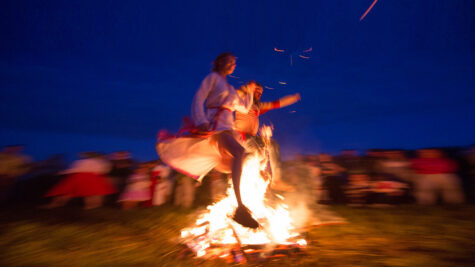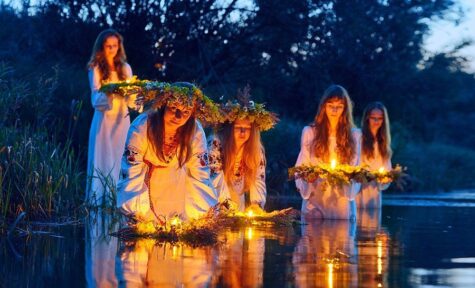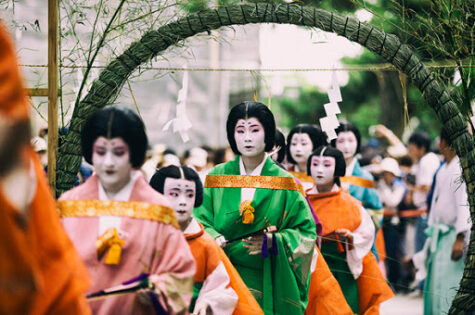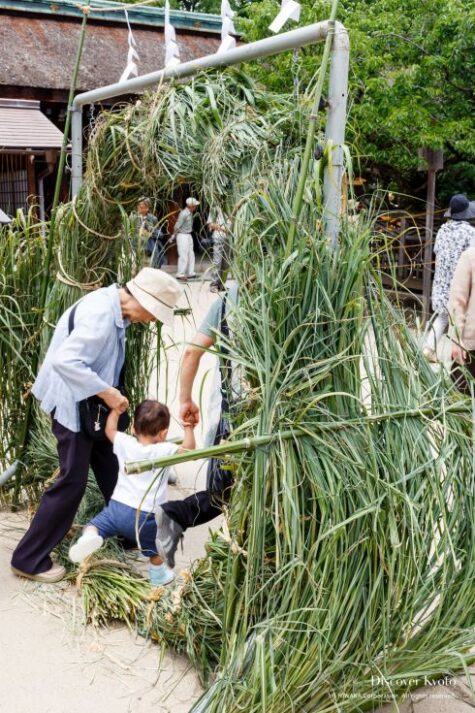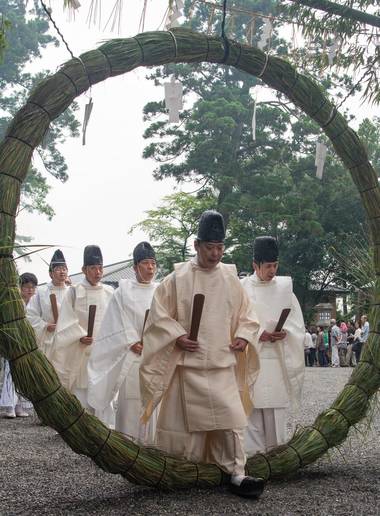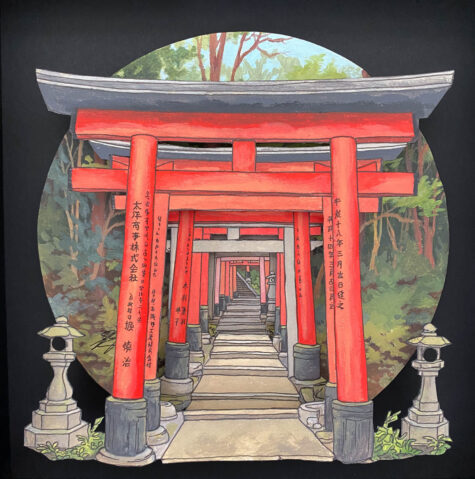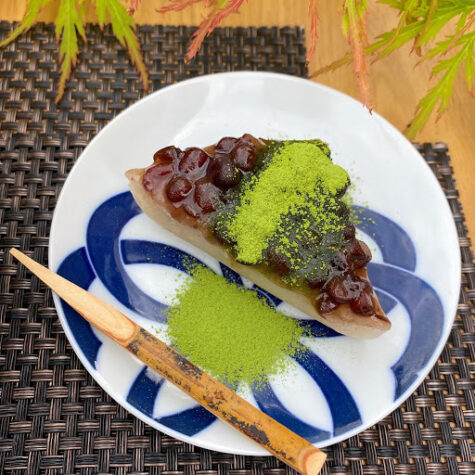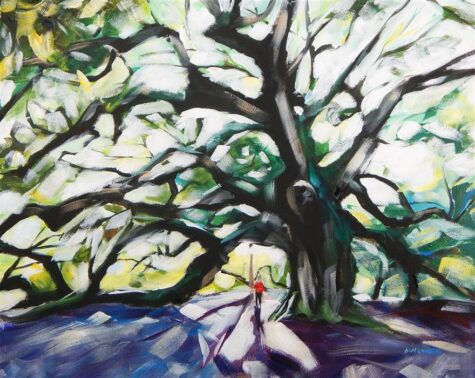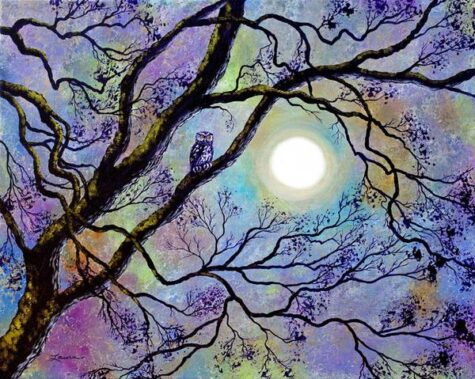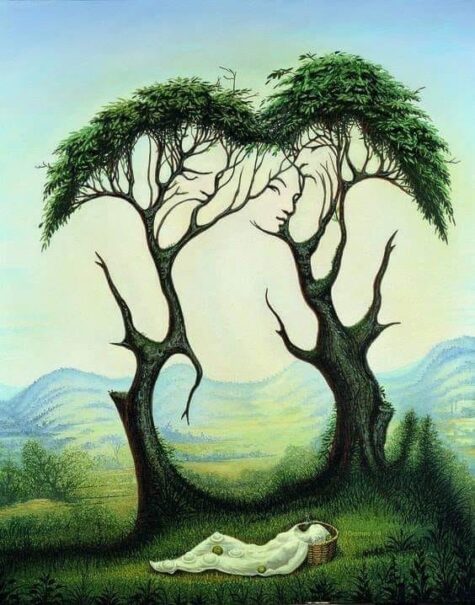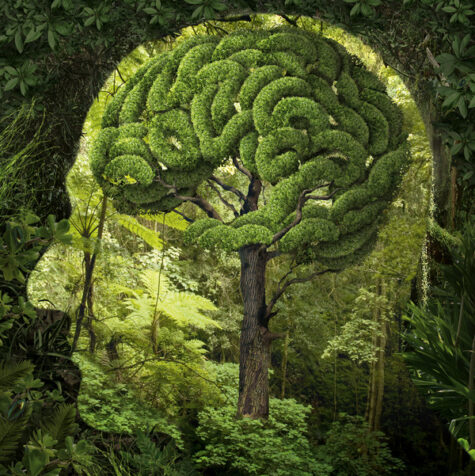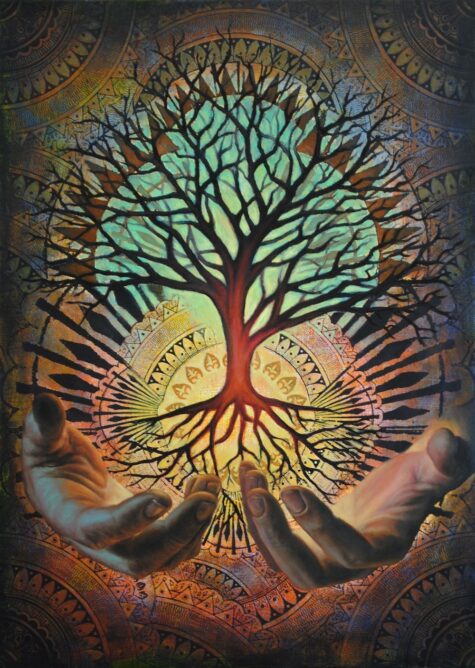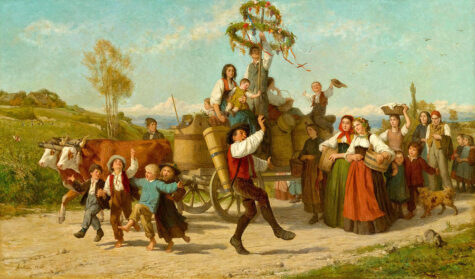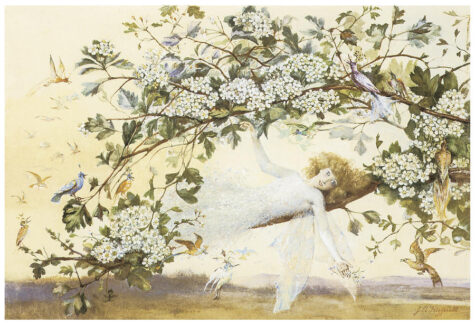June
Kupala Night and Ivan Kupala Day is celebrated in Ukraine, Poland, Belarus and Russia from the night of July 6 to the day of July 7 on the Gregorian calendar. This corresponds to June 23 to 24 on the traditional Julian calendar.
The celebration is linked with the summer solstice when nights are the shortest and includes a number of Slavic rituals. This holiday symbolizes the birth of the summer sun – Kupalo.
In the fourth century AD, this day was Christianized and proclaimed the holiday of the birth of John the Baptist. As a result, the pagan feast day “Kupala” was connected with the Christian “Ivan” (Russian for John) which is why the Ukrainian, Belarusian and Russian name of this holiday combines “Ivan” and Kupala which is derived from the Slavic word for bathing.
The two feasts could be connected by reinterpreting John’s baptizing people through full immersion in water. However, the tradition of Kupala predates Christianity. The pagan celebration was adapted and reestablished as one of the native Christian traditions intertwined with local folklore.
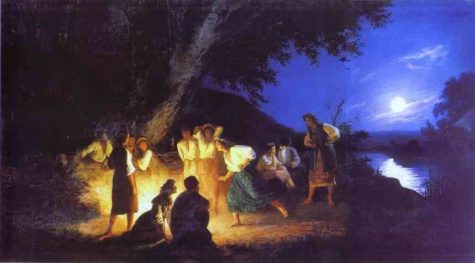
And Then It Was Banned
In the XVIII century, there were a number of documents testifying to the fierce struggle of the Church and secular authorities with the Kupala rite.
For example, in 1719 Hetman of Zaporizhzhia Army, Chairman of the Cossack state of the left bank of Ukraine, Ivan Skoropadskyi issued a decree “On parties, fisticuffs, gatherings on the holiday of Ivan Kupala etc.”, which granted the right to physically punish (tie up and beat with sticks) and excommunicate from the Church all participants of Kupala games.
In 1723, Przemysl Cathedral in Bereziv banned dancing and entertainment near the Kupala fire. In 1769, Catherine II issued a decree banning the holiday. And despite all the prohibitions, the pagan nature of folk rituals was strong. The church did not ban the holiday, but it did try to fill it with Christian content.
It is the pagan essence, mysticism, marriage-erotic motifs of Kupala rite that attracted the attention of many researchers and artists. Thanks to public ritual such art masterpieces as the Opera “Ivana Kupala” by S. Pysarevskyi; folklore work of L. Ukrainka “Kupala in Volyn”; the story of M. Gogol “Night of Ivan Kupala”; the film of Yurii Ilienko “Night on Ivan Kupala”; the Folk Opera of Y. Sankovych “When the fern blooms.” The latter during 40 years was banned and only in 2017 its world premiere took place on the stage of the Lviv Opera.
Kupala Today
At the beginning of the twentieth century Kupala rite gradually began to disappear. Today it exists in the “revived”, or rather “introduced” in Soviet times (during the anti-religious struggle) form of staged ceremony.
Although the magical meaning of rituals was leveled, and the celebration gained artistic value, the main pagan ritual actions have reached us – weaving of wreaths by girls and letting them into the water; honoring Kupala tree with dances; kindling the fire and jumping over the fire; ritual bathing; burning or sinking of trees; the burning of sacks of straw or stuffed dolls; the ceremonial dinner.
It is interesting that the name of the holiday, and the ritual fire, and decorated tree are called “Kupalo”, “Kupailo” or “Kupailytsia”. These are also the main elements of the rituals, which are based on the cult of fire, water and vegetation. Rituals symbolize the union of male (fire) and feminine (water) elements, were carried out with the aim of ensuring productivity, health, procreation.
On the territory of Ukraine for many centuries Kupala customs changed and they were not everywhere equally preserved. The majority were saved in Polissia as one of the more archaic zones of the Slavic world.
The holiday is still enthusiastically celebrated by the younger people of Eastern Europe. The night preceding the holiday (Tvorila night) is considered the night for “good humor” mischiefs (which sometimes would raise the concern of law enforcement agencies).
On Ivan Kupala day itself, children engage in water fights and perform pranks, mostly involving pouring water over people. Many of the rites related to this holiday are connected with the role of water in fertility and ritual purification.
According to ancient traditions, Ivan Kupala is the festival of the sun, and the most important role in mystical rites belongs to the power of fire. Our ancestors believed that the fire is the sun-embryo in the womb. Therefore, in the Kupala night taken to jump over the fire.
On Kupala day, young people jump over the flames of bonfires in a ritual test of bravery and faith. First, the oldest of the young men jumped over the fire.
For the highest jumpers it predicted a good harvest and prosperity for his family. Then pairs would jump, traditionally it would be a boy and a girl, but I assume that in some areas it’s permissible for pairs of any kind to take the jump together. If the couple is successful in their jump over the fire – they will certainly marry. The failure of a couple in love to complete the jump, while holding hands, is a sign of their destined separation. And anyone entering the flames during their jump can expect trouble
On the evening of July 6, unmarried girls take wreaths they have woven and throw them into the water. Unmarried men then try to grab the one belonging to the girl they are interested in. If you snag a wreath, the girl who made it will be expected to kiss you and the two of you will be paired up for the evening.
Girls may also float wreaths of flowers (often lit with candles) on rivers, in an attempt to gain foresight into their romantic relationships based from the flow patterns of the flowers on the river.
When the fun subsides, many people light candles from the hearth on pre-prepared wreath baskets and go to the river to put them on the water and thus honor their ancestors.
There is an ancient Kupala belief that the eve of Ivan Kupala is the only time of the year when ferns bloom. Prosperity, luck, discernment, and power befall whom ever finds a fern flower. Therefore, on that night, village folk roam through the forests in search of magical herbs, and especially, the elusive fern flower.
Traditionally, unmarried women, signified by the garlands in their hair, are the first to enter the forest. They are followed by young men. Therefore, the quest to find herbs and the fern flower may lead to the blooming of relationships between pairs within the forest.
It is to be noted, however, that ferns are not angiosperms (flowering plants), and instead reproduce by spores; they cannot flower.
In Gogol’s story The Eve of Ivan Kupala a young man finds the fantastical fern-flower, but is cursed by it. Gogol’s tale may have been the stimulus for Modest Mussorgsky to compose his tone poem Night on Bald Mountain, adapted by Yuri Ilyenko into a film of the same name.
Sources:
Nagoshi no Harae, literally “summer passing purification ceremony” is one of Japan’s most celebrated great rituals and is steeped in tradition. The purification ritual has been performed at shrines since ancient times, in the hope of atoning for misdeeds that have been committed in the first half of the year and to pray for the latter half yet to come. It is a chance for redemption and a new start for the remainder of the year.
Traditionally performed on the last day of the sixth month, the custom is still enjoyed today in modern Japan, every June 30, at many shrines across the country. Because the Nagoshi-no-Oharai falls between rice sowing and harvest, this ritual is a time of relaxation and community celebration.
In order to participate you can join in on June 30th when the priests of Shinto shrines all across Japan lead large crowds in the practice, or you can try it by yourself.
Create a ring of Miscanthus reeds, (also called Chinese Reed, Ramie, or Elephant Grass). Simply bow, pass through the wreath and circle back to the front from the left, pass through again to the right, then pass through one last time. Just remember left, right, left like the sign for infinity ∞. As you pass through the ring, reflect on your year.
The key to all rituals performed in Shinto is the harmony between heaven and earth. The rituals create the space and process whereby you can return to the fullness of the inborn Kami — the divine in each person.
In Shinto, the Kami is the object of reverence. A word that cannot be translated
adequately into English, its most common translation is “God.” However, Stuart D. B. Picken writes in his “Historical Dictionary of Shinto” that “Divinity, the divine, or the mysterious are better candidates because they are less specific in the imagery they generate.”
Where to participate in Kyoto
Several of Kyoto’s most famous and popular shrines host the event including:
- Kitano Tenmangu Shrine, home to the largest chinowa in Kyoto (approximately five meters in height), which is set up at the shrine gate.
- Kamigamo Shrine also performs the ritual as well as handing out paper dolls to the participants, which are floated down the river to rid you of misfortune.
- Yoshida Shrine is another popular host of the event, where participants who offer a doll amulet to the deity are gifted a wreath in return.
The Ritual at the Tsubaki Grand Shrine
Tsubaki Grand Shrine was established over 2,000 years ago and has been the site of the same daily Shinto purification rituals ever since, including the Nagoshi-no-Oharai.
During the Nagoshi-no-Oharai, the Torii pathway leading to the Tsubaki Grand Shrine is transformed with hundreds of people attending this ritual. The Torii gateways are a distinctive symbol of Shinto and represent a gateway between heaven and earth. Although stylized over the centuries, the original gateway was most likely a simple rope hung between the trees or posts to mark an area considered sacred.
At the Tsubaki Grand Shrine, there are a succession of Torii leading up to the Honden, (the main worship hall), where the rituals are conducted. This Honden holds about 75 people and is built in the classical style of plain, unpainted Japanese cypress, with a stylized roof distinguished by ridge posts.
Along the sides of the gravel Torii pathway hang ropes tied with white paper streamers, called gohei, signifying the boundary of sacred space. The gohei are made in different sizes by the Shinto priests and are also considered sacred.
A large sacred ring, called chi-no-wa, made of loosely twisted Miscanthus reeds, is constructed in front of the Honden. There are numerous purification rituals as people wait for the start of the Nagoshi-no-Oharai.
The Nagoshi-no-Oharai ritual begins in the main worship hall with the traditional Oharai prayers and purification.
During the purification ritual, the Shinto priests cascade kirinusa (small cut pieces of sacred rope and cloth) onto all the worshippers in the Honden. Some priests then run out of the Honden and through the crowd lining the pathway, tossing kirinusa on them.
When they complete their daily Oharahi-no-Kotba, the worshippers line the Torii pathway in anticipation of the afternoon ritual service. Following the Ohara-no-Kotobai, the chief priest (Guji) leads all the other priests, who carry crates of paper dolls, three times through the chi-no-wa in a figure eight pattern.
Worshippers follow behind a reed boat (kaya-fune) carried by a senior priest. They know their routine in the ritual, a yearly tradition that passes from generation to generation, and wait patiently in silence for their opportunity to walk through the circle of reeds. This gentle, respectful procession reflects the learned knowledge of all participants.
Passing though the chi-no-wa, although complex, is executed smoothly and is amazing to watch. The paper dolls in the crates come from all those who have visited the Tsubaki Grand Shrine in the previous six months with special prayers, impurities, pollution, uncleanness, concerns or indulgences called tsumi. Each paper doll includes the name of the person, his or her birthday and a personal stamp.
(The Japanese use stamps in their daily lives to identify paperwork and bills. When you receive or pay for something, you get the stamp of the person who processed it, confirming that you have seen the document.)
These paper dolls are symbolic of a person’s tsumi and have been purified at the Tusbaki Grand Shrine before they’re carried by the Shinto priest through the circle of reeds and then to the riverbank.
After completing the walk through the circle of reeds, the priests go to a location on the river close to the shrine. Over the days leading up to the ritual, the priests have created a sacred space along the riverbank by hanging rope with gohei across the river. Along the far shoreline, a priest also places a large pole with hanging gohei.
In all Shinto purification rituals, sake and salt are used. The Guji (chief priest) sprays these into the sacred river water while reciting prayers. The Guji also make an offering to the Kami by presenting a Japanese evergreen – sakaki –the same offering presented at all Shinto shrines.
After the river purification is completed, the priests fling the paper dolls into the air like hundreds of white petals and let them float to the sea, signifying the release of impurities.
A Shinto Prayer for Purification
The kami shall lend ear to the sacred words.
No offences shall remain unpurged.
They shall be scattered and blown afar
by Heaven’s winds
descending through the eight-fold clouds.
Morning mists shall be cleared
by the morning winds,
Just as the mists of evening shall be swept away
by evening winds.
As a large ship anchored in a harbor
casts off the morrings from its bow
and is released into the great expanse of ocean,
So shall we be released of our impurities
As the trees of the thick grove rooted yonder
are cleared away with a sharp sickle~
So shall our offences be purged and swept away.
We pray that these impurities be swept away and that
The kami grant us purification to restore
the natural order.
Let the impurities be swept away by the kami Seoritsu Hime
Who dwells in the swift rivers that cascade
from the top of the high mountains
and from the top of the low mountains,
Carrying the impurities out to the great expanse of ocean;
There, where the river meets the great sea,
Hayakitsu Hime, who dwells
within the whirling myriad tides,
Shall open wide and swallow the impurities;
Let the door open, then, from the bottom country,
And the kami called Ibukido Nushi shall cause
great winds to expel the impurities
to the root country.
There, the kami called Haya Sasura Hime,
the quiet wanderer of the root country,
will sieze and dissolve the impurities,
Ridding us of imperfection and
returning us to our pristine natural state.
Grant us purification, grant us clarity.
We pray to the Heavenly Kami
and to the Earthly Kami ~
To all the myriad of kami
we recite this norito with awe and reverence.
Please hear these humble words.
Minazuki
The seasonal sweet minazuki, a type of steamed cake topped with azuki beans, is often sold during the ritual period. It is traditionally eaten on June 30th to ward of evil, ill health and bad luck for the second part of the year. The colour of minazuki is said to resemble ice to cool you from the summer heat. Here’s a recipe from Tokyo Pony.
You will need:
- A square container around 4×4 inches
- Something to steam the wagashi in (I used a bamboo steamer)
- 15g of kuzu root ( if it is not in a powder and more in chunks crush into a powder)
- 15g of glutinous rice flour ( the kind for making dango )
- 30g of sifted plain white flour
- 30g of unrefined caster sugar
- 100ml of water
- x1 can of sweet red beans
Combine the kuzu powder and dango flour then add a little of the water to make a paste, then add the rest and mix together. Then add in your flour and sugar and mix to combine.
Fill your container with water and tip it out ( this will just stop your wagashi from sticking ) then fill your container with your mixture, keeping a few tablespoons for later.
Place your container in a steamer and steamer over simmering water for about 20 minutes.
After this time take out your container from the steamer and add around 3/4 of the can of your sweet red beans to the top, spreading them out. Add the few spoonfuls of the remaining mixture you saved over the beans and pop back in the steamer for a further 10 minutes.
Remove and allow to cool in the fridge. Cut the wagashi while it in still in the container. If you cut it in an X from corner to corner, you will have 4 triangles. Carefully ease out the first piece, once you have one out the others are easily removed. I wouldn’t recommend tipping it upside down as you may spoil the look of your minazuki.
There you have it. They are nice enjoyed with a matcha tea you could even dust the top with matcha or kinako if you like.
The History of Nagoshi no Harae
Nagoshi no Harae was first established during the Nara Period (710-794) and was traditionally performed on the last day of the sixth and twelfth months of the lunar calendar at the Imperial court and Shinto shrines. The great purification at the Imperial court briefly came to an end due to the Onin War (1467-77), but continued to flourish at shrines. At some point, the twelfth month purification (harae) was abandoned and the sixth month purification (nagoshi no harae) became grander in scale.
The origin of the ritual comes from an ancient Japanese legend about the wandering god Susano’o no Mikoto. A poor man, Somin Shorai, showed the disguised god every luxury he could afford when asked for a place to stay the night. In return for housing the god for the night, he was given a chinowa wreath woven from reeds and instructed to wear it for protection.
In a turn of good luck, Somin and his descendants managed to escape plague and illness that befell the land. This story led to the practice of passing through the large Nagoshi no Harae chinowa wreath to ward off disaster and misfortune.
Sources:
- Culture Trip
- Tsubaki Shrine
- Starr King School
- Discover Kyoto
- Shinto Norito
All humans are said to have a special Daimon or a Guardian Angel assigned to them at the time of their birth whose role is to protect and guide them throughout their life. Other Angels or Guardian Spirits may help with specific tasks along the way. By helping people, a deep friendship is forged that strengthens over time.
Hesiod wrote about divine beings that kept watch on mankind. In Works and Days, he says,
“After the earth had covered this generation… they are called pure spirits dwelling on the earth, and are kindly, delivering from harm, and guardians of mortal men; for they roam everywhere over the earth, clothed in mist and keep watch on judgements and cruel deeds, givers of wealth; for this royal right also they received… For upon the bounteous earth Zeus has thrice ten thousand spirits, watchers of mortal men, and these keep watch on judgements and deeds of wrong as they roam, clothed in mist, all over the earth.”
A person should always thank their Guardian Spirit for their help. Some people can feel their presence through sight, touch, smell or sound. Some may even have dreams and visions about them. These are subtle means of communication and should not be overlooked.
There are several ways to develop a dialog or a relationship with your Guardian Angel:
- Write your angel a letter.
- Angels enjoy all mediums of art, so try singing to them or painting them a picture.
- Say a prayer to your angel.
- Simply start talking to your guardian angel.
- Create a small altar or dedicated sacred space in honor of your Daemon.
Today is an excellent day to begin a more conscious relationship with the Guardian Spirit that has been with you from the day you were born. Light a candle and spend some time in quietude, so that you can thank your Guardian Spirit and listen for its voice.
Remember, your Guardian Angel is not your “property” or your “pet. ” They might not always do what you ask them to do. Also be aware that Guardian Angels are beings of light and will never harm nor be unkind to you. They will always steer you in a direction that is in your best interests, and you will always have the choice to ignore their gentle nudges.
Sources:
Oak month falls during a time when the trees are beginning to reach their full blooming stages. The mighty Oak is strong, powerful, and typically towering over all of its neighbors. The Oak King rules over the summer months, and this tree was sacred to the Druids.
The longest day of the year and the shortest night fall during the Oak Month. Known as the Summer Solstice, celebrations revolve around the power of the Sun at its zenith. Folklore decrees that “He who sleeps on the shortest night shall sleep all year”, meaning that this is a time for action not rest.
- Dates: June 10 – July 7
- Celtic Name: Duir
- Language of Flowers: Bravery, Hospitality
- Qualities: Tree of the Gods, Strength, Power, Longevity, Endurance, Sacred, Fire, Lightning, Protection, Love, healing,
- Themes: Strength, Power, Fertility, Luck, Success.
The Oak tree has long been venerated by people of many cultures as a symbol of strength and power. The Celts called this month Duir, which some scholars believe to mean “door”, the root word of “Druid.”
The Oak is connected with spells for protection and strength, fertility, money and success, and good fortune. Carry an acorn in your pocket when you go to an interview or business meeting; it will be bring you good luck. If you catch a falling Oak leaf before it hits the ground, you’ll stay healthy the following year.
Feel energized by the power of the Sun and Oak during this energetic time of year. Harness powerful solar energies for Oak Moon work to bring cheer and success to your life. Energy at this time should concentrate on areas of life that fall under sunny auspices such as health, success, prosperity, and blessings. Cast energy that injects solar flare into your projects by decorating you home with gold and yellow. Wear orange to boost your vitality and stamina.
Often linked with the fairies and ghosts, Midsummer brings the perfect opportunity to summon assistance from the spirits. Ask for help to being beneficial results from creative plans.
Oak the Stabilizer
The Celtic druids knew that, when a child was born under the Oak sign, it’d possess a special gift of strength. People from this Celtic tree astrology sign become protectors of the weak and speak for those who don’t have a voice. They are generous, helpful, and gentle. The Oaks have a deep understanding of history and ancestry and maybe that’s the reason why many of them become teachers.
Oak is a manly tree, and the people born under its rule are “people of action”. These people were given the ability to be the protectors of the weak and oppressed. They are literally the embodiment of spiritual power, great courage and determination.
Oak people are usually well-built and physically strong. They are straightforward and honest. They always try to find the easiest way to achieve their goal; they never shy away from dealing with problems and never use intrigues or do something that is not right.
Suitable partners for this crusader of the Celtic tree zodiac are Ash and Reed, but can reach harmony with Ivy signs too.
Oak Magick and Lore
The Oak is a sign of strength, both the strength of its branches and wood, and its strengthening qualities as a medicine and magical tree. All cultures have revered the Oak and sought such strengthening qualities, and that strength can be seen throughout the lore.
Tied to the ancient term for “druid” as “Oak knowledge” Oak has long been associated with knowledge and wisdom. We can see this also in the Native American lore, where Oak “makes space for councils”.
The Oak can be used as a haven for restoration. When your spirit needs rest and comfort it can be soothed beneath the tree’s vast branches and many sacred rituals were conducted in the shadow of an Oak tree in Ancient Britain. Meditating with your spine resting on the trunk of an Oak tree soothes the nervous system and induces feelings of inner peace.
Oak trees conduct the energy of endurance and strength, offering a magical remedy for fear and despair. They bring courage and protection from adversity.
The great size and age of the Oak made it a symbol of the continuity of the community. The water that collects in the dips in its branches was though to be sacred and used to cleanse and heal the body of negative energy.
Each Oak tree was believed to be the home to a multitude of faeries and each acorn was thought to be the home to a sprite. Bringing an acorn into the house was one way to develop a stronger relationship to the faerie world.
Oak has low electrical resistance and is often struck by lightning. So forests of Oak attracted violent electrical storms – and as lightning was seen as a message from the gods, so Oak came to be associated with the gods of storm, thunder, and lightning.
Thunder was said to be the voice of Zeus – and an Oak tree that had been struck by lightning was believed to be particularly sacred.
A purification ritual for the Oak Moon
You can burn Oak leaves to purify the atmosphere and banish fear and doubt. You will need:
- Small bottle of wine
- Basket
- Pestle and mortar
- Needle and thread
- Fireproof bowl
- Charcoal disc and matches
On the night after the full moon go to an Oak tree and pour a libation of wine onto the roots, asking the tree for its help. Gather a basket of leaves and sew them together, then hang up the leaves to dry out for three days.
When the leaves have dried, carefully remove the thread and pound the leaves with a pestle and mortar into incense. Light the charcoal in the fireproof dish. When it glows red add the dried leaves to create an energetic purification smoke.
Sources:
June 9 is St Columba’s day which is said to be the luckiest day of the year, so a good day to start any project you wish to flourish. St. Columba’s feast no longer appears on the General Roman Calendar, but is a Feast Day in Ireland’s National Calendar.
Saint Columba’s Feast Day has also been designated as International Celtic Art Day. The Book of Kells and the Book of Durrow, great medieval masterpieces of Celtic art, are associated with Columba.
St Columba is the patron saint of bookbinders and poets, and was said to have performed over a hundred miracles in his life – you don’t get saints like that any more! He did everything from expelling demons, calming storms and wild animals, and restoring a child to life, to more mundane miracles such as miraculously sending a staff to a colleague who had managed to leave it behind when he went on a voyage, and my favorite: exorcising a demon from a bucket and restoring the spilt milk to it.
There is even a story that has been interpreted as the first reference to the Loch Ness Monster. According to Adomnán, Columba came across a group of Picts burying a man who had been killed by the monster. Columba saves a swimmer from the monster with the sign of the Cross and the imprecation, “Thou shalt go no further, nor touch the man; go back with all speed.”
The beast flees, terrified, to the amazement of the assembled Picts who glorified Columba’s God. Whether or not this incident is true, Adomnán’s text specifically states that the monster was swimming in the River Ness – the river flowing from the loch – rather than in Loch Ness itself.
In another story, a poor farmer had only five cows; Columba blessed them, saying that the farmer would one day have 105 cows. Adomnán recorded that this came true, but didn’t say how long it took. He did say, though, that the man never had any more than 105 cattle: whenever the cattle reached that number, something would happen to the extra.
Columba would not, though, allow any cows on the island of Iona. He said that women always follow cows to tend them, and thus, cows bring trouble. One time, five men were fishing in the river Sale and caught only five fish. Columba said “God will provide a bigger fish for me; try your nets again,” and they caught the biggest salmon they had ever seen.
St. Columban, abbot, is the patron of shepherds, and one of the patron saints of Scotland. There is a tradition of rye or oat cakes baked in his memory.
A St Columba Day Story
There is a story which is told at this time of the year about the little children of northern Scotland, and our children of southern Ohio love to hear it. How easily we are united in brotherhood by common interest!
As June 8, the eve of St. Columba’s Day, arrives, our green hills are flicked with puffs of white wool. The older sheep have been sheared, but the fat little ones are as broad as they are long. The newborn ewe lambs have learned to skip and dance, while the young rams pretend to be very fierce as they bump their curly heads in play.
Just so the hills of the Hebrides must have looked when St. Columba and his twelve companions arrived in Scotland away back in the sixth century. The people were called Picts at that time and their lives depended upon sheep raising.
It was an easy step for them to understand the message of the Good Shepherd. St. Columba, in imitation of his Master, gathered Scotland’s souls to himself, gave them a sheepfold of faith in the island Monastery of Iona. As a “faithful and wise servant, whom his Lord setteth over his family, he gaveth them their measure of wheat in due season.”
It is true that he died at the foot of the altar while he was blessing “his sheep” in about the year 600, but some of his people remember him still.
Oak Cakes for St Columba Day
A rye or oat cake is baked in the Hebrides in honor of St. Columba. A small silver coin is placed in the dough, and the cake is toasted before a fire of rowan, yew or oak branches. The children of the house dance in impatience until the cake is finished because it is theirs and theirs alone.
Excitement rises to a fever pitch when the cake is divided, for the child who receives the silver coin has always gotten the crop of new lambs for the season. Families did know how to delegate authority before the days of 4-H groups. You see, young shepherds are trained on actual hills and on actual responsibility.
Here’s a recipe:
This oat flour cake is the perfect gluten and dairy-free treat. It is made with wholesome oats and sweetened with honey. It only requires one bowl so grab the ingredients and let’s start making this cake!
Oat flour is so easy to make, it is just ground oats! You can buy pre-made oat flour but it’s so much cheaper to make it yourself. Simply add quick cook or rolled oats to your blender or food processor; and blend until flour forms, approximately 30 seconds – 1 minute.
Measure your oat flour amount AFTER you have ground it into flour, this makes for a more accurate ratio in recipes. Also, make sure the oat flour is ground finely like traditional flour, otherwise, the cake will have a weird texture.
Use a metal or aluminum pan for this recipe, using a glass pan will result in uneven baking. The inside of the cake will be underdone and the outside will be very dark and possibly overcooked.
Ingredients
- 2 cups oat flour
- 1 teaspoon baking powder
- ½ teaspoon baking soda
- ½ teaspoon cinnamon
- ½ teaspoon salt
- ¾ cup honey
- ¼ cup olive oil
- 1 teaspoon vanilla extract
- 2 eggs
Honey Coconut Frosting
- ½ cup coconut cream, from a can
- 2 tablespoons honey
Begin making the oat flour cake by preheating the oven to 350 degrees F. Grease an 8×8 inch aluminum baking dish with cooking spray or line with parchment paper.
Next, add all of the ingredients to a large bowl and mix until well combined and smooth.
Pour the batter into the baking dish. Bake for 25-30 minutes, or until a toothpick comes out clean.
While the cake bakes, make the frosting. Scoop cream off the top of the can of coconut cream and add to a small bowl with 2 tablespoons of honey. Mix with a whisk or hand mixer until smooth.
Remove the cake from the oven and allow it to cool on a wire rack for about 15 minutes. Then remove the cake from the pan, frost, if desired and cut into equal-sized pieces. Enjoy!
Sources:
June 8th is World Oceans Day, a day to honor and protect the world’s oceans. We celebrate World Oceans Day to remind everyone of the major role the oceans have in everyday life. They are the lungs of our planet, providing most of the oxygen we breathe. It is the oceans which help to regulate our climate and ultimately are the source of all of our water, which is the reason we are able to exist.
Life emerges from salt water, both metaphorically speaking and literally Each person begins their Earthly incarnation swimming in their mother’s salty amniotic fluid. Ocean water is also used to signal rebirth in the next realm.
The purpose of the Day is to inform the public of the impact of human actions on the ocean, develop a worldwide movement of citizens for the ocean, and mobilize and unite the world’s population on a project for the sustainable management of the world’s oceans. They are a major source of food and medicines and a critical part of the biosphere. In the end, it is a day to celebrate together the beauty, the wealth and the promise of the ocean.
Clearly, today is sacred to all deities of water and seas including Mananan, Poseidon, Neptune, La Sirene, Aegir, Oceanus, Yemaya, Kanaloa, and Agoueh, amongst many many others.
If you are by the sea, take some time to walk the beach and pick up any rubbish that you find, especially plastics.
An Ocean Spirit Wishing Spell
Address your request to Aphrodite, Poseidon, Yemaya, Sirene, Aegir, Neptune, or any other ocean spirit you choose. The request should be addressed specifically to someone. Don’t send out a generic request. Write your request on rice paper, or some other biodegradable paper. Launch it into the waves and await your response.
Important Facts About The Ocean
Just knowing about World Oceans Day is not enough for your some people to be able to grasp the whole concept of how important the ocean is for human survival. To encourage others to celebrate our oceans and strive to make a difference, you could share some fun facts on World Oceans Day and how important the oceans are:
- 97% of Earth’s water is in the oceans, which is home to more than 200, 000 known species and millions of unidentified organisms.
- The oceans purify the air we breathe by absorbing 30% of the carbon dioxide in the air, which also helps in reducing the effects of global warming and climate change.
- Oceans are the world’s largest source of protein, and more than 2.6 billion people depend on the oceans as their primary source of protein.
- 40% of the oceans of the world are today affected by human actions causing pollution, depletion of fisheries, loss of coral reefs and endangerment of marine species. Seven out of the 13 great whale species are endangered today.
- 13, 000, 000 tons of plastic leak into the ocean water each year. It has been predicted that there will be more plastic than fish in the ocean by 2050. Over 100, 000 marine wildlife animals are killed each year due to plastic contamination of the oceans.
Sources:
June 7th is the festival of the Spirits of Oak trees, known as Dryads. Each tree is believed to have its own spirit which can manifest and pass on wisdom.
A dryad is a tree nymph or tree spirit in Greek mythology. Drys signifies “oak” in Greek, and dryads are specifically the nymphs of oak trees, but the term has come to be used for tree nymphs in general, or human-tree hybrids in fantasy. They were normally considered to be very shy creatures except around the goddess Artemis, who was known to be a friend to most nymphs.
- Also known as: Sidhe Draoi, Faerie Druids, Tree Nymphs.
Though the Dryads’ name has been linguistically connected to the Oak, like the Celtic priests known as Druids, they are not particular only to these trees. Indeed many Dryads are said to have a stronger association to Willow trees (Salix species). Willows have traditionally been associated to the moon and the Dryads may be observed or heard singing harmoniously on moonlit nights, for these nature spirits are said to be devotees of the lunar goddess Tana (also known as Diana or Selene).
Dryads may be observed also during daylight, though often only fleetingly moving through the greenery. Unlike the Greek Hamadryads, the Dryads are not bonded to a single tree and though they may have an individual favorite, they are free to move about between them.
Whilst the Greco-Roman Dryads have a male counterpart (known as a Drus), the Celtic Dryads are generally regarded as being female. Also unlike the various Nymphs (nature spirits most specifically recorded in Greek and Roman myth), the Celtic Dryads are not particularly sociable towards humans, though they are infinitely more likely to try and avoid us rather than do us harm. However it has been suggested that they may have communed with Druids in the distant past.
The Dodona Oracle
The Dodona Oracle was located in Epirus, Greece. It was a sacred grove of oak trees originally identified with Gaia that was later attributed to Zeus or Jupiter. The oak trees were seen as oracles who held prophetic information for the future. People interpreted the rustling of their leaves to determine the correct actions to be taken. According to historian Herodotus, the Greeks believed the oracle of Dodona to be the oldest oracle in Greece.
By 200 AD this sacred grove had been reduced to one oak. Emperors and pilgrims continued to consult the sacred tree until 392AD when Emperor Theodosius cut it down.
A Dryad Story
Eurydice, the wife of Orpheus, was a dryad. When she died, Orpheus undertook a journey to the Underworld and because of the beautiful music he played for Hades and Persephone, they agreed that Eurydice could return with him – as long as Orpheus was able to restrain himself from turning to look at her until they were both in the upper world.
They made the long journey back to the land of the living, but Orpheus could hear no sound behind him, no clue that his wife was actually following. This preyed on his mind so much, but he managed to restrain himself until he stepped out once more into the sunlight. He turned quickly to greet Eurydice, only to see that she had not yet escaped the shadow of the Underworld, and as he watched she was pulled back into the land of the dead.
A Tree Meditation
This practice is key to working with trees. Gaining a slow, steady state of consciousness, just sitting and “being” with a tree of any species has profound effects upon our well being. With regular practice, this can be developed further to fine-tune our senses in order to become more aware of the spirit presence of the tree and its energetic qualities.
Try making yourself comfortable on the ground, with your back against a tree trunk, and breathing deeply and steadily for five minutes. With each in breath, let your body awareness rise up into the branches, straightening and stretching your back slightly, and focusing your attention on the branches and air above you. With each out breath, send your awareness down into the earth.
Take your time, and if your mind wanders that’s fine—just bring your attention gently back to this present moment once again. Use your imagination and be like the tree: still, strong, with deep roots and the ability to reach up high and far out into the world without losing your center.
With patience and practice the Tree Mediation may assist you in becoming aware of the tree’s spirit presence, its own particular feeling and even its personality. You may get feelings of tingling warmth when you enter the tree’s energy field, and you may even have shifts in emotion or fleeting images cross your mind. These are all known to be ways in which tree spirits communicate with humans.
In some cases, the tree spirits might appear as humanoid beings. The tree spirit may take on any form, and the images it presents will all be forms of communication, so allow yourself to approach this intuitively, thinking mythically about the spirit contact rather than trying to apply logic or any formal set of rules or symbolism.
Make biodegradable offerings to the tree, such as gifts of spring water, and in time you may be able to develop a relationship with your chosen tree spirit, if they are willing, and will find that you can work together in a variety of ways, just as you would with other spirit allies (such as familiars and elementals, etc.).
Grow Your Own
The best way to work with trees magically is to get your hands dirty first: gather nuts, berries, and seeds and sow your own-even a small container on a windowsill can be enough to get a new tree. They’ll probably need a period of cold to germinate, so be patient.
Tend to these carefully, and with most trees it will take a year or two before they get so big they need to be planted in the ground. If you can, try making your own grove or sacred space encircled by trees you have grown or planted yourself, or have just one “tree ally” in a special place.
These powerful spirit beings will respect the care you have put into them, and be valuable magical allies to call upon in need—as well as wonderful spirit friends that will grow with you as the years go by, and for generations to come.
On the Difficulty of Conjuring up a Dryad
This is a tinted charcoal drawing in Rob Greenwood’s Dryad series. The title comes from a poem by Sylvia Plath which describes the difficulty of identifying the dryad within the tree. The Dryads are still there but they are difficult and ambiguous to identify. Here’s an excerpt from the poem:
‘My trouble, doctor, is: I see a tree,
And that damn scrupulous tree won’t practice wiles
To beguile sight…
My tree stays tree….
Here’s a link to Spotify if you’d like to listen to her read the whole poem. Sylvia Plath Reading Her Poetry. She wrote another poem about Dryads, which I have included here in it’s entirety:
A Plethora of Dryads
Hearing a white saint rave
About a quintessential beauty
Visible only to the paragon heart,
I tried my sight on an apple-tree
That for eccentric knob and wart
Had all my love.
Without meat or drink I sat
Starving my fantasy down
To discover that metaphysical Tree which hid
From my worldling look its brilliant vein
Far deeper in gross wood
Than axe could cut.
But before I might blind sense
To see with the spotless soul,
Each particular quirk so ravished me
Every pock and stain bulked more beautiful
Than flesh of any body
Flawed by love’s prints.
Battle however I would
To break through that patchwork
Of leaves’ bicker and wllisk in babel tongues,
Streak and mottle of tawn bark,
No visionary lightnings
Pierced my dense lid.
Instead, a wanton fit
Dragged each dazzled sense apart
Surfeiting eye, ear, taste, touch, smell;
Now, snared by this miraculous art,
I ride earth’s burning carrousel
Day in, day out,
And such grit corrupts my eyes
I must watch sluttish dryads twitch
Their multifarious silks in the holy grove
Until no chaste tree but suffers blotch
Under flux of those seductive
Reds, greens, blues.
Sources:
4th of June is St Saturnina’s day, patron saint of farmers and wine merchants – and who is now believed to be ‘purely legendary’.
I’d suggest that here we have yet another hidden Pagan festival, this time dedicated to farmers and wine growers. Saturnina is the feminine form of Saturn, the Roman god of farmers and those who work with the earth. At this time of year, and especially looking at her patronages, it would be reasonable to have a festival to encourage a good harvest for farmers and wine growers.
The Legend of St Saturnina
Her legend states that she came from a noble German family (her father was a king, and that she took a vow of celibacy at the age of twelve. When her parents forced her into marriage when she turned twenty, she fled from Germany into France.
The man to whom she had been promised, a Saxon lord, pursued her into France after receiving approval to do so from Saturnina’s parents. He found her hiding with some shepherds at Arras; she had been working as a maidservant. He attempted to rape her, and when she resisted him, he decapitated her.
The lord miraculously drowned in a fountain, and Saturnina then carried her own head in her hands, and as witnessed by the townspeople, carried her head to the church of St. Remi, which was in the next village: Sains-Les-Marquion. She was then buried there.
Another tradition states that Saturnina placed her head on a stone at Sains-lès-Marquion, proclaiming herself to be the last human sacrifice the town would ever suffer.
Sources:
There is a lot to celebrate in June. This is a list of pretty much everything that goes on during the sixth month of the year. Many of these dates change from year to year. The days that change are marked with this » symbol.
June Lore and General Info

Astronomical Events
- June 10 » Annual Solar Eclipse
- June 10 » New Moon
- June 21: Summer Solstice
- June 24 » Full Moon – Honey Moon, Supermoon
Astrological Events
Depending on which astrological system you adhere to, these are the signs that show up in June of 2021. Be aware that some of these dates will vary from year to year. Unlike the Sun signs which might just shift by 1 or 2 days, the dates of the various Moon signs will vary widely from year to year. The same holds true for the Chinese Zodiac. The Celtic Tree Signs are based on an arbitrary system and stay the same from year to year.
Western Astrology
The June Sun begins in Gemini and finishes up in Cancer:
- May 20 thru Jun 21 » Sun in Gemini
- Jun 21 thru Jul 22 » Sun in Cancer
The moon cycles through the signs as follows:
- May 30 – Jun 1 » Moon in Aquarius
- Jun 1 – Jun 3 » Moon in Pisces
- Jun 3 – Jun 6 » Moon in Aries
- Jun 6 – Jun 8 » Moon in Taurus
- Jun 8 – Jun 11 » Moon in Gemini
- Jun 11 – Jun 13 » Moon in Cancer
- Jun 13 – Jun 16 » Moon in Leo
- Jun 16 – Jun 18 » Moon in Virgo
- Jun 18 – Jun 20 » Moon in Libra
- Jun 20 – Jun 22 » Moon in Scorpio
- Jun 22 – Jun 24 » Moon in Sagittarius
- Jun 24 – Jun 26 » Moon in Capricorn
- Jun 26 – Jun 28 » Moon in Aquarius
- Jun 28 – Jul 1 » Moon in Pisces
You will notice that the Moon might begin the day in one sign and by the end of the day may have moved into another sign, so timing matters if you are wanting to be precise.
The Celtic Tree Signs in June:
- May 13 to Jun 9: Hawthorn Tree Month
- Jun 10 to Jul 7: Oak Tree Month
- Jun 21 (Summer Solstice): Day of the Heather
The Alternative Celtic Zodiac is as follows:
- Hornbeam: May 31 – Jun 10
- Aspen: Jun 11 – Jun 20
- Birch: Jun 21 (Summer Solstice)
- Apple: Jun 22 – Jul 2
The Chinese Calendar and Zodiac
We are currently in the year of the Ox (sometimes referred to as the Cow). Each Month is also assigned a specific animal. Here’s what shows up in June 2021.
- Snake: May 5 – Jun 4 (Chinese Zodiac – Stem Branch Calendar)
- Snake: May 12 – Jun 9 (Lunar Calendar – 4th Month)
- Horse: Jun 5 – Jul 6 (Chinese Zodiac – Stem Branch Calendar)
- Horse: Jun 10 – Jul 9 (Lunar Calendar – 5th Lunar Month)
Note: The traditional Chinese Astrology birth chart is built by the Chinese Stem Branch Calendar, not the Chinese Lunar Calendar, which I think is really confusing. Because of a difference in time zones, the lunar months will have different pattern between China and the USA.
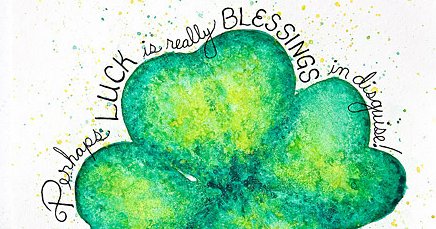
Lucky and Unlucky Days
You might want to plan moving, traveling, major purchases, court dates, and weddings around these dates, avoiding the unlucky days and utilizing the lucky ones.
- These are the lucky days in June:
10, 11, 15, 22 and 25. - These are the unlucky days in June:
1, 5, 6, 9, 12, 16, 17, 18 and 24.
Fatal Days
The tenth a pallid visage shows,
No faith nor truth the fifteenth knows.
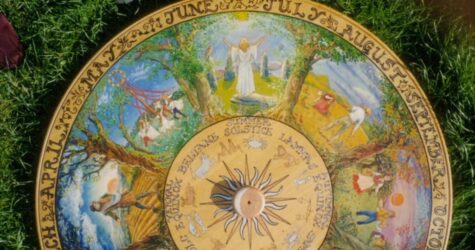
Holidays and Holy Days
Many of the holidays begin on the eve of the night before and end on the eve of the day of. It’s also important to remember that the dates of archaic festivals and feast days may vary widely depending on the source.
June 1
- 1: The Festival of Carna – the Roman goddess of bodily organs.
- 1 thru 2: Festival of Juno
June 3
- 3: The Festival of Bellona – the Roman goddess of war.
- 3: Pharmakos
- 3: Vat Purnima
June 4
- 4: The Rosalia
- 4 » Dakini Day (Tibetan)
June 5
- 5: World Environment Day
- 5 » Day of Ekadashi (Hindu)
June 6
June 9
- 9: Festival of Vesta – the Roman goddess of the hearth.
- 9 » Night of Hekate Suppers
June 11
- 11: King Kamehameha Day
- 11: Festival of Mater Matuta – old Italian goddess of the dawn.
- 11: Holiday of the Happy Gnomes
- 11 » The Noumenia
June 12
- 12: Zeus’ Day
- 12 » Celebrating The Agathos Daimon
June 14
- 14 » Dragon Boat Festival (see also Boat Blessing April 26)
- 14: Vidar’s Day
- 14: Birthday of the Muse
- 14: Flag Day
June 16
June 17
- 17: Ludi Piscatari
June 19
- 19: Never Again Day
- 19: Emancipation Day
- 19 » Bawming of the Thorn
June 20
- 20: Bald Eagle Day
- 20: Corpus Christi
- 20 » Fathers Day
- 20 and 21 » Hemis Festival – dates vary
June 21
- 21 » Day of Ekadashi (Hindu)
- 21: Litha
- 21: Yule (Southern Hemisphere)
June 23
- 23: Rousalii
- 23: Midsummer’s Eve also St John’s Eve
June 24
- 24: Feast of the Dews
- 24: Sânziene – A Romanian Midsummer Festival
- 24: Midsummer
- 24: Inti Raymi, Peruvian Festival of the Sun
- 24: Bonfires of St John
- 24: The Festival of Fata – the Roman goddesses of fate and chance.
- 24: World UFO Day (sometimes celebrated on July 2)
June 27
June 28
- 28: Vidovdan
June 29

Saint Days
There is a surprising amount of magick associated with Saint days This is a very short list of the Saint days in June, there are many many more. As time goes by I may end up listing them all, but for now, this is what I have.
- 2: St Erasmus of Formia’s Day
- 9: St. Columba of Iona
- 15: Saint Vladimir’s Day
- 15 or 28: Saint Vitus Day
- 24: Saint John’s Day
- 29: Feast Day of Saint Peter and Saint Paul

Recipes For June
- Midsummer Ritual Mead – Litha, Midsummer, the Summer Solstice
Links to many more seasonal recipes, including recipes for new and full moon ceremonies, ancient Greek and Roman holidays, Asian festivals and etc. can be found on our Seasonal Recipes page.
Notes:
Any June lore, almanac, astrological, and celebration dates that have been shared after this post was published can be found by searching the June posts to see what’s new.
A lot of work went into this post. It was compiled from various sources by Shirley Twofeathers for The Pagan Calendar, you may repost and share without karmic repercussions, but only if you give me credit and a link back to this website. Blessed be.
The month of the Hawthorne is the time of fertility, masculinity, sexual energy, and fire. Coming right on the heels of Beltane, this month is a time when male potency is high — if you’re hoping to conceive a child, get busy this month!
The hawthorn is closely linked to witches due to an ancient belief that it was created from witches who had been transformed into trees. Any magic performed beside the hawthorn or during its month is though to be twice as powerful.
- Dates: May 13 – June 9
- Celtic Name: Huath,
- Language of Flowers: Hope
- Qualities: Healing, Protection, Passion, Commitment, Challenge
- Themes: Fertility, Masculine Energy, Fire, Business and Professional, Magical Protection
Take advantage of the fertile, prosperous energies of the month of the Hawthorn Moon to help you spice up your life.
This is the time for lovers to attend to matters of the heart, as the Celtic fire festival of Beltane heralds the start of summer. Celebrated on the first full Moon after the May tree (hawthorn) has blossomed, cattle were driven between two fires to purify them before moving to summer pastures. Young people were adorned with blossom and lovers lay in fields to empower their relationship and the crops with fertility and prosperity.
The Hawthorn has a raw, phallic sort of energy about it — use it for magic related to masculine power, business decisions, making professional connections. The Hawthorn is also associated with the realm of Faerie, and when the Hawthorn grows in tandem with an Ash and Oak, it is said to attract the Fae.
Adorned with flowers in spring, berries in autumn, and bare thorns in winter, the seasonal appearance of hawthorn has led to its sacred association with the three faces of the Great Goddess. Maiden (virginal white flowers of spring), Mother (rich, fertile red berries of autumn). And Crone (the cruel thorns of winter).
Hawthorn wood was traditionally used in amulets and charms. The wood grows into many twisted patterns, thought to be the origin of the love knot charm. As an amulet, the flowers were thought to ward off depression. The Romans placed such amulets in cradles to protect babies from curses.
Hawthorn the Illusionist
Just like Gemini in western astrology, the Hawthorn from the Celtic tree astrology isn’t all that it appears to be. Their exterior world can be completely different from the inner landscape and they can show a new side to you each day. If you hang out with Hawthorn signs too often, you’ll see that they put the term “never judge a book by its cover” to the test. They have a never-dying creative flame, always full of energy and curiosity.
This sign from the Celtic horoscope can adapt to any situation and can be both a good listener and give inspiring speeches. A good match for this shapeshifter can be the Ash or Rowan sign.
Magick and Lore
Hawthorn has a strong association with fertility, passion and love. When the Ancient Greek goddess Hera touched Hawthorn blossoms, she conceived twins.
Hawthorn seems to be particularly associated with wedding celebrations, perhaps because of its longtime reverence as the tree of that iconic May Day marriage of springtime that’s re-enacted in villages across Britain – the crowning of the May Queen, often bedecked in may blossom, and her joining together with the Oak King.
In Celtic writings, Cuchulainn calls hawthorn ‘most difficult night’ and Oengus calls hawthorn ‘whitening of the face’ – a moment when the face goes white at the thought of the challenges that lie before us.
Hawthorn has traditionally been seen as the tree of protection. As a hedgerow, it protects many little birds and animals, and up to 50 different species of insect. Hawthorn also protects boundaries – in Cornwall, clods of earth with a sprig of hawthorn were often left on boundary stones to protect the boundary of a farm or village area. Hawthorn hedges are still seen as powerful boundary protection for our modern homes, gardens and fields.
The ‘fairy trees’ or ‘faery thorns’ were respected and it was seen as very advisable never to harm a hawthorn, nor never to cut it except for ritual purposes when you would make a prayer and ask permission before taking any. Specifically, you should not clear hawthorn for practical purposes lest misfortune befall you!
Soulmate Attraction
Finding the right person to form a relationship with is not an easy task. Fortunately, you can harness the energetic forces of the Hawthorn to help you find that special someone.
Beside a hawthorn tree place a red candle in the earth and light it, saying,
“Trust by flowers white,
passion by berries red,
and protection of thorn.
May we grow together”.
Next describe your ideal partner on a red piece of paper. Bury it, allow the candle to burn. Decorate your door with Hawthorn blossoms, and you will find true love in the next summer.
Note: If you do not have the time to stay with the candle until it burns all the way down, bury what is left of it next to the paper. Do not leave a burning candle unattended next to a tree.
Sources:
